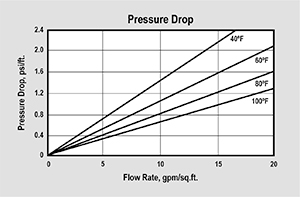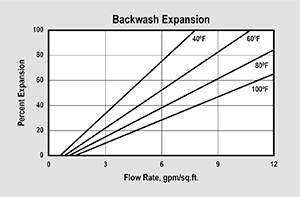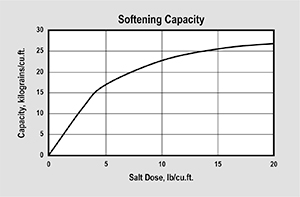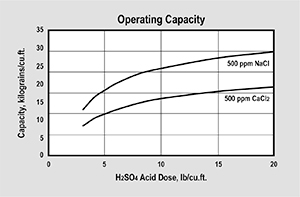 |
| PRESSURE DROP — The graph above shows the expected pressure loss per foot of bed depth as a function of flow rate at various temperatures. |
| |
 |
| BACKWASH — The graph above shows the expansion characteristics as a function of flow rate at various temperatures. |
| |
| |
| APPLICATIONS |
| Softening |
 |
| SOFTENING CAPACITY — Capacity is based on 2:1 Ca:Mg ratio, 500 ppm TDS as CaCO3, 0.2% hardness in the salt, and 10% brine concentration applied co-currently through the resin over 30 minutes. No engineering downgrade has been applied. |
| |
Demineralization
ProSoft High Porosity (Hydrogen Form) can be used as the cation component in demineralization configurations where a hydrogen form cation resin is coupled with a hydroxide form anion resin. ER10010 is ideal for high flow rate polishers and where high resistance to mechanical, thermal, and oxidative stresses is required. |
| |
 |
| OPERATING CAPACITY — Capacity is based on 500 ppm of stated salt (as CaCO3) with 0% alkalinity, 36 inch bed depth, flow rate of 2 to 4 gpm per cu.ft., and a minimum of 30 minutes chemical injection time. Sulfuric acid concentration must be stepwise when calcium concentration exceeds 20% of total cations. No engineering downgrade has been applied. |
| |
Radwaste
ProSoft High Porosity is ideally suited for radwaste applications. The high crosslinking content gives it improved resistance to chemical damage caused by ionizing radiation. Structural integrity is maintained up to approximately 1 x 109 rads exposure. |
| |
| |
| ProSoft™ is a trademark of Safe Water Technologies, Inc. |
|
|
| |
Features: |
|
| |
• |
Macroporous structure greatly increases life in stressful applications where resin degradation due to thermal and oxidative effects is anticipated |
|
| |
• |
Uniform particle size, low pressure drop |
|
| |
• |
Superior chemical and physical stability |
|
| |
• |
Conforms to paragraph 21CFR173.25 of the Food Additives Regulations of the US FDA |
|
| |
• |
Certified to NSF/ANSI Standard 61 * |
|
|
| |
| PART NUMBER |
| Sodium Form |
ER10009 |
| Hydrogen Form |
ER10010 |
|
| |
| PHYSICAL PROPERTIES |
| Polymer Structure |
Styrene/DVB |
| Polymer Type |
Macroporous |
| Functional Group |
Sulfonic Acid |
| Physical Form |
Spherical beads |
| Resin Color |
Tan |
| Ionic Form (as shipped) |
Sodium or Hydrogen |
Total Capacity
Sodium Form
Hydrogen Form |
> 1.65 meq/mL
> 1.6 meq/mL |
Water Retention
Sodium Form
Hydrogen Form |
45 to 55%
50 to 60% |
| Swelling (Na to H) |
3 to 5% |
| Screen Size Distribution |
16 to 50 (US mesh) |
| Maximum Fines Content |
1% (< 50 mesh) |
| Maximum Sphericity |
95% |
| Uniformity Coefficient |
1.6 approx. |
Approx. Ship. Wt.
Sodium Form
Hydrogen Form |
50 lb/cu.ft.
48 lb/cu.ft. |
|
| |
| SUGGESTED OPERATING CONDITIONS |
Maximum Temperature
Sodium Form
Hydrogen Form |
300°F (149°C)
280°F (138°C) |
| Minimum Bed Depth |
24 inches |
| Backwash Expansion |
25 to 50% |
| Maximum Pressure Loss |
25 psi |
| Operating pH Range |
0 to 14 |
Regenerant Concentration
Salt Cycle
Hydrogen Cycle (Option 1)
Hydrogen Cycle (Option 2) |
10 to 15% NaCl
5 to 10% HCl
1 to 8% H2SO4 |
| Regenerant Level |
4 to 15 lb/cu.ft. |
| Regenerant Flow Rate |
0.5 to 1.5 gpm/cu.ft. |
| Regenerant Contact Time |
> 20 minutes |
| Displacement Flow Rate |
Same as dilution
water |
| Displacement Volume |
10 to 15 gal/cu.ft. |
| Rinse Flow Rate |
Same as service flow |
| Rinse Volume |
35 to 60 gal/cu.ft. |
| Service Flow Rate |
1 to 10 gpm/cu.ft. |
|
| |
| |
|
* CAUTION: DO NOT MIX ION EXCHANGE RESINS WITH STRONG OXIDIZING AGENTS. Nitric acid and other strong oxidizing agents can cause explosive reactions when mixed with organic materials such as ion exchange resins.
|
| |
ADDITIONAL INFORMATION:
SWT Ion Exchange Resin Guide
Cation Resin Selection Chart
Resin Capacity Comparison Chart
|
| |
| |
|
This information has been gathered from standard materials and or test data that is believed to be accurate and reliable. Nothing herein shall be determined to be a warranty or representation expressed or implied with respect to the use of such information or the use of the goods described for any particular purpose alone or in combination with other goods or processes, or that their use does not conflict with existing patent rights. No license is granted to practice any patented invention. It is solely for your consideration, investigation and verification.
|
|




